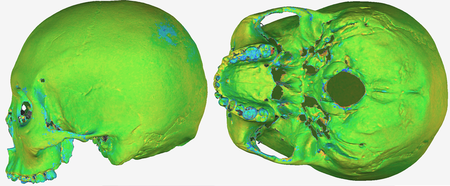Cranial Variation

There is just something about skulls. Perhaps because facial recognition is so well developed in humans, one can look into (really into) a specimen’s eyes and imagine an identity, personality, time, and place. However, we do not study the crania of human and non-human primates simply because they spark imagination. Skulls have provided biological anthropologists a wealth of information about adaptation and evolutionary history. Aspects of cranial form may be diagnostic of cognitive function, sensory specialization, adaptations to climate, or dietary demands. Yet it is also clear that not all cranial–or more generally, phenotypic–variation is an outcome of natural selection. Both modern human cranial diversity and cranial differentiation between Neandertals and Homo sapiens are substantially consistent with predictions from the neutral theory of evolution. These findings highlight the relevance of cranial variation for understanding ancient population history and structure, and also make it clear that accounting for shared evolutionary history is important if selection is to be inferred from patterns of cranial diversity.
Using statistical approaches derived from population and quantitative genetics theory, our lab studies cranial diversity and its evolutionary drivers across multiple taxa and taxonomic levels: global diversity among recent human groups, differentiation between Homo sapiens and Neandertals, comparisons between the H. sapiens-Neandertal and common chimpanzee clades, and patterns of cranial variation between fullbred and hybrid rhesus macaques (as a model for Late Pleistocene human admixture).
Human Dental Variation
Most humans have teeth. They play important roles in our lives, from enabling us to bite, chew, and smile, to requiring regular maintenance and care, occasionally even jeopardizing our sanity and health when they grow diseased. Culturally, they play a role in sexual selection and signaling, with different populations around the world striving for different aesthetic ideals. Even without cultural modification, however, teeth vary across the globe in their size, shape, and form. A plethora of bumps, grooves, fissures, ridges, and other features may be expressed to different degrees in different dentitions, and while typically no single population has truly unique features, populations do vary systematically in the frequency with which certain features are expressed. This systematic variation enables researchers to infer group membership and population history by examining the assortment of traits expressed in a collection of dental specimens. Teeth bear additional information, too – as permanent tooth enamel is deposited during adolescence, it records pre-adult nutrition and diet in its form and composition, and studies of wear and pathology can investigate nutrition and diet later in life. Teeth can be used to bracket the approximate age and sex of an individual, and are often found and used in forensic and paleontological contexts because they’re so resilient to physical and chemical change. Often, teeth are the only biomaterial to be preserved at a paleontological or archaeological site, sticking around long after everything else has been degraded or destroyed.
Suffice it to say, teeth provide us with a valuable window into the past, so we study them. In addition to cataloguing global patterns of continuous and discrete dental variation, we’re interested in developing and applying cutting edge statistical methods to dental data to see what teeth might tell us. Do global distributions of different dental features accurately reflect population history and phylogeny, such that tooth morphology can be used to estimate evolutionary relationships between both extant and extinct groups? Can teeth be used to reliably identify an individual’s group membership, such that the presence and frequency of certain features in paleodentitions correspond to the presence of some hominin group at a given site? What sort of selective pressures, if any, acted on teeth historically and prehistorically to structure the global patterns of variation we see today? How might recent technological advancements aid us in both collecting and presenting information about teeth? We investigate these questions and others here at UC-Davis, making use of dental data to better understand the processes by which our species and closely related ones arose.
